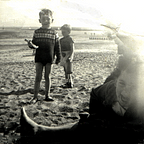Why is Michelle (partly) in French?
“Michelle” was a tune that I’d written in Chet Atkins’ finger-picking style. There is a song he did called “Trambone” with a repetitive top line. He played a bass line while playing a melody. I wanted to write something with a melody and a bass line in it … an instrumental in C.[5]
Creating beautiful melodies came naturally to Paul McCartney. Finding the words that go together well required more work. Especially in a language he did not speak.
In his 2021 documentary with Rick Rubin, Paul suggests that John Lennon played an important role in the genesis of Michelle. It was his songwriting partner who reminded him of ‘that French thing’ and encouraged him to work it up into a track for Rubber Soul. Lennon was referring to a tune that dated back the first years of the Quarrymen.
At that point, John Lennon was nominally a student. at Liverpool School of Art. Paul, who had slid out of education, entered his new friend’s world by proxy, attending the parties if not the classes.
Perhaps to impress his new social set, Paul sometimes would pretend to be French at parties. That he did this by finger-picking Chet Atkins may have seemed eccentric. For McCartney, however, the jazzy chord sequence awoke memories of ‘Juliette Greco, the French bohemian thing.’ He was probably thinking of Ascenseur Pour L’Echafaud (1957) a French film by scored by Miles Davis, a former lover of Greco.
Paul’s party props included a stripy t-shirt and a string of onions. What he didn’t have was the French language, which he had never studied. He had overcome this major obstacle by vocalizing a dummy lyric in cod French.
This would obviously not do for Beatle record, particularly one that would keenly listened to by a vast army of Yeah Yeah fans in France. Some authenticity was required.
The reworked song lyric started with a French-sounding name. Michelle was a variation of Milord from the eponymous Edith Piaf. Milord in the original is the name a French ‘girl of the port’ (!) gives to an English swell she spies on the street.
McCartney may have been unaware that he was gender switching avant la lettre. His primary focus transforming his dummy French words into real ones. He consulted his friend Ivan’s wife, Jan, a teacher of French at a local school.
‘I need a French words to rhyme with Michelle.”
Jan came up with the very plausible ma belle, which lead on to trickier linguistic territory.Paul now needed a translation of ‘these are words that go together well’. Jan suggested sont les mots qui vont très bien ensemble. This sounded a little odd to French ears but worked brilliantly in musical terms.
Recording & Release
Because it was only on four little tracks, it was very easy to mix. There were no decisions to make, we’d made them all in the writing and in the recording {this took} ….half an hour, maybe. Then it wentt on a shelf, in a quarter-inch tape box. And that was it. That was the only thing we ever did to Michelle.
Michelle was recorded on 3 November 1965. It was started in the afternoon and completed in the evening. Astoundingly, the distinctive arrangement was essentially improvised in a single take. John provided the ‘I love you’ bridge, which heavily leans on Nina Simone’s version of I Put a Spell on You.
Finally, Paul added his lead vocal. His ‘lead base’ would influence generations of musicians but again appears to have been worked out during the session.
Another innovatory feature was the ritard or deliberate slowing of tempo. Some initially assumed this was a mistake but it was a conscious attempt to imitate something from the original Milord. The Beatles frequently did not know the names of the techniques they borrowed but they were gifted at making the work with their own material.
‘Rubber Soul’ was released in the UK a month to the day later. On December 6, it came out in the US, Michelle was seen as the stand-out track, with the heaviest radio play on US stations. It was then released as a single in several countries including Hong Kong and Italy.
Curiously, however, no single from the album was released in the two major markets: the US and the UK. This was probably a commercial decision — part of a long term move to nudge record buyers towards albums. There also appears to have been some resistance to the specific choice of Michelle as a single.
John Lennon, for one, considered Michelle to be too ‘soft’ to represent brand Beatles in the singles charts. The use of French was a particular source of this unease, recalling the old joke about social climbing: pretentious moi?
After the break up of the Beatles, Michelle was finally released as a single in France. In a peculiar choice of B side, it was coupled with Run for Your Lifeone of the nastiest songs in the Beatles catalogue. In 1971 John Lennon confessed that he hated Run for Your Life — both for its misogynist message and because it was a ‘filler’ rushed out to complete his quota of songs
Michelle proved a popular song for other artists, with 32 officially released covers, including this French version by The Atoms:
